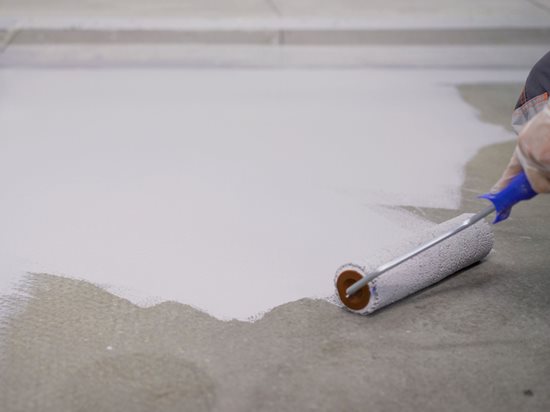Two effective options for waterproofing a basement floor are epoxy paint and sealed concrete. Both options are affordable, durable, and provide adequate waterproofing.
Epoxy paint dries thick and hard, ensuring the necessary durability to maintain a basement floor. Additionally, implementing waterproofing measures in the structure’s design can limit or prevent basement water intrusion. To protect the home or building from basement moisture infiltration, it is important to identify and address possible water transport mechanisms through the walls and floor.
Another option is to seal/coat the interior walls with a suitable masonry waterproof product, forming a watertight bond to prevent seepage. Following these steps, you can effectively waterproof your basement floor and protect against water damage.

Credit: paradigmconcretefl.com
Understanding Basement Waterproofing
Two effective options for waterproofing a basement floor are epoxy paint or sealed concrete. Both options are affordable, durable, and provide adequate waterproofing. Epoxy paint dries thick and hard, ensuring the longevity of the floor.
Sealed concrete also prevents water intrusion into the basement.
Why Waterproof A Basement?
Waterproofing a basement is essential to protect your home or building from water damage. Basements are prone to moisture, which can lead to various issues such as mold growth, structural damage, and deterioration of the flooring. Waterproofing the basement ensures that water does not seep through the walls or floor, keeping the space dry and preventing potential damage.
Identifying Water Transport Mechanisms
To effectively waterproof the basement, it is crucial to identify the water transport mechanisms that can lead to moisture infiltration. These mechanisms include:
1. Capillary action: Water can travel upwards through porous materials, such as concrete, through capillary action, resulting in moisture seeping through the basement floor.
2. Hydrostatic pressure: When the water table rises, it exerts pressure on the foundation walls and floor, causing water to seep through cracks and gaps.
3. Condensation: Moisture can accumulate on basement walls and floor due to temperature differentials between the cool basement and the warm outside air, leading to condensation and water buildup.
By understanding these water transport mechanisms, you can take appropriate measures to mitigate them and waterproof your basement effectively.
Options For Waterproof Flooring
Two popular waterproof flooring options for your basement are epoxy paint and sealed concrete. Both options are affordable, durable, and effective.
1. Epoxy paint: Epoxy paint forms a thick and hard coating on the basement floor, providing excellent durability and water resistance. It is easy to apply and dries to a smooth and glossy finish. Additionally, epoxy paint comes in various colors, allowing you to customize the look of your basement floor.
2. Sealed concrete: Sealing the concrete floor with a waterproof sealant creates a barrier that prevents water from seeping through. The sealant penetrates the porous concrete and forms a protective layer on the surface. Sealed concrete is a long-lasting and low-maintenance option for waterproofing your basement floor.
Both epoxy paint and sealed concrete offer reliable waterproofing solutions for basements. Consider your specific needs and budget to choose the option that best suits your requirements.
Understanding the importance of basement waterproofing, identifying water transport mechanisms, and exploring suitable flooring options can ensure a dry and protected basement. Waterproofing your basement is an investment that pays off by safeguarding your home or building from potential water damage and enhancing its longevity. So, take the necessary steps to waterproof your basement floor and enjoy a moisture-free space.
How To Waterproof A Basement Floor
To waterproof a basement floor, consider using epoxy paint or sealed concrete. These options are affordable, durable, and provide adequate waterproofing. By implementing these methods, you can limit water intrusion and protect your home from moisture infiltration.
Clearing The Basement And Preparing The Floor
Before waterproofing your basement floor, it is important to clear out any items or furniture that may be in the way. This will give you a clear workspace to properly prepare the floor for waterproofing. Remove any debris, such as dirt or dust, as it can interfere with the adhesion of the waterproofing products to the concrete. Additionally, check for any existing moisture or water leaks that must be addressed before proceeding with the waterproofing process.
Cleaning The Floor And Removing Efflorescence
To ensure proper adhesion of the waterproofing products, cleaning your basement floor thoroughly is crucial. Start by sweeping away any loose dirt or debris. Then, use a degreaser or concrete cleaner to remove stains, oil spills, or other contaminants. Scrub the floor with a stiff bristle brush to ensure a deep clean. One common issue with concrete floors is the presence of efflorescence, which is a white powdery substance that forms on the surface. To remove efflorescence, use a wire brush or a specialized efflorescence cleaner to scrub away the residue and ensure a clean and smooth surface for waterproofing.
Filling Holes And Cracks
Before applying the waterproofing products, filling in any holes or cracks in your basement floor is important. These imperfections can compromise the effectiveness of the waterproofing system. Use a concrete patching compound or hydraulic cement to fill larger holes and cracks. For smaller cracks, a crack sealer or filler can be used. Follow the manufacturer’s instructions for proper application and drying time. Once the holes and cracks are filled, use a scraper to level the patched areas and ensure a smooth surface.
Applying Waterproofing Products
Now that your basement floor is clean and the holes and cracks have been filled, it’s time to apply the waterproofing products. Several options, such as epoxy paint, sealants, or waterproofing membranes, are available. Choose a product specifically designed for basement floors and follow the manufacturer’s instructions for proper application. Use a roller or a brush to apply an even coat of the waterproofing product, making sure to cover the entire surface area. Allow the product to fully dry before adding coats or finishing touches.
Other Methods For Waterproofing Basements
Explore different methods for waterproofing basements, including epoxy paint and sealed concrete for basement floors. These affordable and durable solutions can provide the necessary waterproofing for maintaining a dry and protected basement environment. Implementing waterproofing techniques during the construction process can also help prevent water intrusion and ensure the longevity of your structure.
Waterproofing The Interior Walls
One effective method for waterproofing basements is to focus on the interior walls. This involves applying a waterproof sealant or coating to prevent water from seeping through. Waterproofing the interior walls can help create a barrier against moisture and protect the basement from potential water damage.
Installing A Damp Proof Membrane
Installing a damp-proof membrane is another popular method for waterproofing basement floors. A damp-proof membrane is a sheet or barrier placed beneath the flooring material, acting as a barrier to prevent moisture from penetrating the floor. This helps to keep the basement dry and free from water damage. Proper installation of a damp-proof membrane is crucial to ensure its effectiveness.
Sealing/coating The Walls With A Masonry Waterproof Product
Sealing or coating the walls with a masonry waterproof product is another effective way to waterproof basements. These products are designed to provide a protective layer on masonry surfaces, such as concrete walls. The waterproof product helps to seal any cracks or gaps in the walls, preventing water from seeping through. The application of a masonry waterproof product should be done carefully and thoroughly to ensure maximum effectiveness.

Credit: www.concretenetwork.com

Credit: www.dustram.com
Frequently Asked Questions On How To Waterproof Basement Floor
What Is The Best Way To Waterproof A Basement Concrete Floor?
The best way to waterproof a basement concrete floor is to use epoxy paint or sealed concrete. These options are affordable, durable, and provide adequate waterproofing. Epoxy paint dries thick and hard, ensuring the durability needed for a basement floor.
Is It OK to Waterproof the Basement Floor?
Yes, it is OK to waterproof a basement floor. Two effective options for waterproofing basement flooring are epoxy paint and sealed concrete. These options are affordable, durable, and provide adequate waterproofing. By implementing waterproofing measures, you can limit or prevent water intrusion in your basement, protecting your home or building from moisture infiltration.
How Do I Waterproof A Concrete Floor?
To waterproof a concrete floor, you have two options: One, dig up the old floor, install a new damp-proof membrane, and replace the concrete slab. Two, use a surface Damp-Proof Membrane (DPM) to isolate the dampness in the floor.
Additionally, you can seal/coat the interior walls with a masonry waterproof product to stop water seepage.
How Do You Waterproof The Inside Of A Basement?
To waterproof the inside of a basement, you can seal/coat the interior walls with a masonry waterproof product. This forms a watertight bond and prevents water from seeping through the walls. This is a cost-effective and durable solution for basement waterproofing.
Conclusion
When waterproofing your basement floor, there are a few options to consider. Epoxy paint and sealed concrete are affordable and durable choices that provide adequate waterproofing. Epoxy paint creates a thick and hard layer that can withstand the demands of a basement floor.
You can effectively prevent basement water intrusion by implementing waterproofing measures into your structure’s design and addressing possible water transport mechanisms. Whether you choose to dig up the old concrete floor or use a surface damp proof membrane, waterproofing the inside of your basement walls will further protect your space from water seepage.

